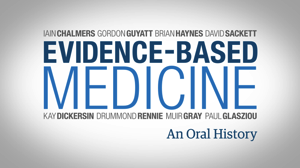Evidence Based Medicine – an Oral History
Andrew Knight writes:

Read MoreThis fascinating video looks at the origins and future of the evidence based medicine movement through interviews with the major players – Guyatt, Sackett, Haynes and more.
Even they have come to see that EBM though necessary is not sufficient for getting evidence-based care to patients. T
hey have some suggested answers for the way forward including hopes for implementation science and the increasing importance of patients/consumers.
It takes 45 mins. Watch here.
Should we stent renal artery stenosis?
Stenting and Medical Therapy for Atherosclerotic Renal-Artery Stenosis — NEJM
Patients with more than 60% renal artery stenosis and hypertension were randomised to receive stunting plus medical treatment or medical treatment alone.
Conclusion:
Renal-artery stenting did not confer a significant benefit with respect to the prevention of clinical events when added to comprehensive, multifactorial medical therapy in people with atherosclerotic renal-artery stenosis and hypertension or chronic kidney disease.
So, should we be stenting renal arteries?
Read MoreNuts to you – in the nicest possible way

Association of Nut Consumption with Total and Cause-Specific Mortality — NEJM
In a study of health professionals, nut consumption was associated with reduced all-cause mortality.
This was primarily due to a reduction in heart disease associated with any nut consumption and a reduction in cancer associated with tree nut consumption
(Hat tip to Essential Evidence Plus.)
Read MoreWarfarin Interactions With Antibiotics
Warfarin Interactions With Antibiotics in the Ambulatory Care Setting [JAMA Intern Med. 2014]
A retrospective, longitudinal cohort study evaluated patients receiving warfarin between January 1, 2005, and March 31, 2011, at Kaiser Permanente Colorado.
CONCLUSIONS AND RELEVANCE
Acute upper respiratory tract infection increases the risk of excessive anticoagulation independent of antibiotic use.
Antibiotics also increase the risk; however, most patients with previously stable warfarin therapy will not experience clinically relevant increases in INR following antibiotic exposure or acute upper respiratory tract infection.
Read MoreNew Lipid Guidelines – Hooray!
This week, the American College of Cardiology and American Heart Association (ACC/AHA) released new guidelines for the management of Lipids.
The new guidelines are a major shift in thinking. They are far closer to the proposed POQ in the discussion elsewhere on this site than to the previous guidelines. Spooky. This is clearly cause and effect. Who would have thought we had that much influence?
Key points in new guidelines.
Treating to LDL cholesterol targets is no longer recommended.
Patients should receive Statins if they fall into one of these four groups.
- Patients with clinical atherosclerotic cardiovascular disease (ASCVD) should receive high-intensity (age, <75) or moderate-intensity (age, ≥75) statin therapy.
- Patients with LDL cholesterol levels ≥ 4.9 mmol/L should receive high-intensity statin therapy.
- Diabetic patients aged 40–75 with LDL cholesterol levels of 1.8–4.9 mmol/L and without clinical ASCVD should receive at least moderate-intensity statin therapy (and possibly high-intensity statin therapy when estimated 10-year ASCVD risk is ≥7.5%).
- Patients without clinical ASCVD or diabetes but with LDL cholesterol levels of 1.8-4.9 mg/dL and estimated 10-year ASCVD risk ≥7.5% should receive moderate- or high-intensity statin therapy.
High-intensity statin therapies are atorvastatin (40–80 mg) or rosuvastatin (Crestor; 20–40 mg). Moderate-intensity statin therapies include atorvastatin (10–20 mg), rosuvastatin (5–10 mg), simvastatin (20–40 mg), pravastatin (40–80 mg), and several others.
With few exceptions, use of lipid-modifying drugs other than statins is discouraged.
Lifestyle modification is recommended for all patients, regardless of cholesterol-lowering drug therapy.
These guidelines use a new ten year risk calculator which includes both coronary events and stroke, and is only available as an Excel spreadsheet currently.
This is different to the calculators used in Australia, as per another discussion on this site.
Join the discussion as we prepare our POQ at this forum
Read More